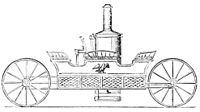met with so many obstacles that even Hancock and Gurney, the most ingenious, persistent, and successful constructors, gave up in despair. Hostile legislation procured by opposing interests, and possibly also the rapid progress of steam-locomotion on railroads, caused this result.
In consequence of this interruption of experiment, almost nothing was done during the succeeding quarter of a century, and it is only within a few years that anything like a business success has
been founded upon the construction of road-locomotives, although the scheme seems to have been at no time entirely given up.
Messrs. Aveling & Porter, J. Scott Russell, Boydell, and a few others in England, and Messrs. Roper, Dudgeon, Fawkes, Latta, and J. K. Fisher, in the United States, have all, at various times, labored in this direction.
The last-named engineer designed his first steam-carriage in 1840, and was still at work at the time of his death, in 1873.
Abroad, a few firms have succeeded, within a few years past, in making a business of considerable extent in constructing road-locomotives for hauling heavy loads, and in building steam road-rollers.
While steam-carriages of high speed, and adapted to the transportation of passengers, have not yet been successfully introduced, a most promising start has been made in the application of steam to the heavier kinds of work on the common road.
The great impediments seem to be the roughness and bad construction of the ordinary highway, the damages arising from the taking fright of horses, the engineering difficulties of construction, and the limited power of the machine as it has usually been built. Hostile legislation might perhaps be placed in the category, but we are probably sufficiently far advanced in civilization today to be able to secure liberal legislation when the people shall be satisfied that the introduction of the road-locomotive will be of great public advantage.
66. The capabilities of the road-locomotive are readily determined by experiment, and the following is an abstract of the results of several series of trials.[1] A trial of a road-engine was made by the well-known French engineer, H. Tresca, in presence of Prof. Fleeming Jenkin, and the report was submitted on January 15, 1868. The results were as follows: 1. The coefficient of traction was about 0.25 on a good road with easy grades. 2. The consumption of coal was 4.4 pounds per horse-power per hour. 3. The consumption of water was 132.2 gallons an hour with the ten-horse engine. 4. The coefficient of ad-
- ↑ Appletons' American Cyclopædia, article "Steam-Carriage."


